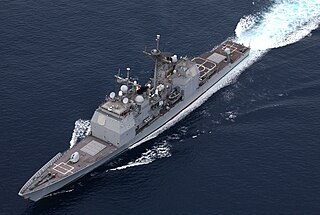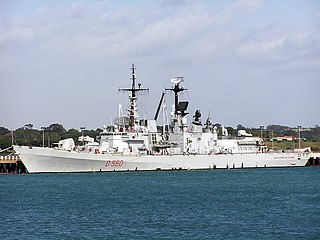The Tartar Guided Missile Fire Control System is an air defense system developed by the United States Navy to defend warships from air attack. Since its introduction the system has been improved and sold to several United States allies.
Contents


The Tartar Guided Missile Fire Control System is an air defense system developed by the United States Navy to defend warships from air attack. Since its introduction the system has been improved and sold to several United States allies.


The Tartar Guided Missile Fire Control System is a component of the overall Tartar Weapons System. It consists of the target illuminators and associated computer systems needed to fire a missile once a target has been identified. It operates in conjunction with the weapon direction systems (WDS), the ship's long-range air search radars, and the guided missile launch system (GMLS) to engage air targets. [1]
The Tartar FCS receives target designation information from the WDS. The system then acquires and tracks the target, positions the missile launcher, programs the missile with intercept data, and lets the WDS know that it is ready to fire. Once the missile is fired, the FCS provides CW illumination of the target and postfiring evaluation. [1]
There are two major families of Tartar FCS: the Mk. 74 and the Mk. 92. The latter is used on the Oliver Hazard Perry-class frigate and the former is used everywhere else. Each Mk 74 includes the AN/SPG-51, a director Mk 73, a computer system, and associated consoles. The Mk. 92 contains a combined antenna system (CAS), a separate track illumination radar (STIR), weapon control consoles, a computer complex, and ancillary equipment. [1]
It was installed on numerous US cruiser and destroyers in the 1960s through early 1990s such as the California-class cruisers, Virginia-class cruisers, Kidd-class destroyers and the Charles F. Adams-class destroyers. It is also in use in other countries such as the fleet escorters of the French Navy Kersaint, Bouvet, Du Chayla and Dupetit-Thouars, and was also in use on Cassard and Jean Bart.
Starting in the middle 1960s a new family of guided missiles referred to as the Standard missiles were developed to replace the poor performing missiles used by existing fire control systems. The RIM-66A/B Standard replaced the earlier RIM-24C Tartar used by the system. The new missile made Tartar into a true medium ranged system. Besides having longer range than the RIM-24, the new missile was more accurate and reliable.
Vessels of the California, and Virginia-class cruisers and the Kidd-class destroyers had their Tartar systems upgraded to modification 14 or 15 standard which enabled them to employ the Standard Missile 2 as part of the New Threat Upgrade (NTU) program. The New Threat Upgrade equipped vessels could utilize the inertial guidance systems on the SM-2 and time share illumination radars for semi-active homing in the terminal phase of the intercept, increasing the number of targets the Tartar system could attack at the same time. The New Threat Upgrade Tartar ships could function nearly as well as Aegis Combat System equipped vessels, except for dealing with saturation missile attacks. The NTU still requires the AN/SPG-51 radar to acquire a lock on the target and illuminate it just before intercept.

The Aegis Combat System is an American integrated naval weapons system developed by the Missile and Surface Radar Division of RCA, and it is now produced by Lockheed Martin.

The Charles F. Adams class is a ship class of 29 guided-missile destroyers (DDG) built between 1958 and 1967. Twenty-three were built for the United States Navy, three for the Royal Australian Navy, and three for the West German Bundesmarine. The design of these ships was based on that of Forrest Sherman-class destroyers, but the Charles F. Adams class were the first class designed to serve as guided-missile destroyers. 19 feet (5.8 m) of length was added to the center of the design of the Forrest Sherman class to carry the ASROC launcher. The Charles F. Adams-class were the last steam turbine-powered destroyers built for the U.S. Navy. Starting with the succeeding Spruance-class, all U.S. Navy destroyers have been powered by gas turbines. Some of the U.S. Charles F. Adams class served during the blockade of Cuba in 1962 and during the Vietnam War; those of the Royal Australian Navy served during the Vietnam War and Gulf War.

The Ticonderoga class of guided-missile cruisers is a class of warships in the United States Navy, first ordered and authorized in the 1978 fiscal year. The class uses passive phased-array radar and was originally planned as a class of destroyers. However, the increased combat capability offered by the Aegis Combat System and the AN/SPY-1 radar system, together with the capability of operating as a flagship, were used to justify the change of the classification from DDG to CG shortly before the keels were laid down for Ticonderoga and Yorktown.

The Kongō class of guided-missile destroyers in the Japan Maritime Self-Defense Force are equipped with the Aegis Combat System, and is the first of few ship classes outside the United States to have that capability. Following a decision made in December 2003, Japan is upgrading their Kongo-class destroyers with Aegis Ballistic Missile Defense System. The upgrade involves a series of installations and flight tests to take place from 2007 to 2010. JS Kongo was the first ship to have the BMD upgrade installed.

The RIM-162 Evolved SeaSparrow Missile (ESSM) is a development of the RIM-7 Sea Sparrow missile used to protect ships from attacking missiles and aircraft. ESSM is designed to counter supersonic maneuvering anti-ship missiles. ESSM also has the ability to be "quad-packed" in the Mark 41 Vertical Launch System, allowing up to four ESSMs to be carried in a single cell.

The General Dynamics RIM-24 Tartar was a medium-range naval surface-to-air missile (SAM), among the earliest SAMs to equip United States Navy ships. The Tartar was the third of the so-called "3 Ts", the three primary SAMs the Navy fielded in the 1960s and 1970s, the others being the RIM-2 Terrier and RIM-8 Talos.

The AN/SPG-51 is an American tracking / illumination fire-control radar for RIM-24 Tartar and RIM-66 Standard missiles. It is used for target tracking and Surface-to-air missile guidance as part of the Mk. 73 gun and missile director system, which is part of the Tartar Guided Missile Fire Control System.

The Mark 13 guided missile launching system (GMLS) is a single-arm missile launcher designed for use on frigates and other military vessels. Because of its distinctive single-armed design, the Mark 13 is often referred to as the "one-armed bandit".

New Threat Upgrade (NTU) was a United States Navy program to improve and modernize the capability of existing cruisers and destroyers equipped with Terrier and Tartar anti-aircraft systems, keeping them in service longer.

The Belknap-class cruiser was a class of single-ended guided-missile cruisers built for the United States Navy during the 1960s. They were originally designated as DLG frigates, but in the 1975 fleet realignment, they were reclassified as guided missile cruisers (CG).

The Albany-class guided-missile cruisers were converted Baltimore and Oregon City-class heavy cruisers of the United States Navy. All original superstructure and weapons were removed and replaced under project SCB 172. The converted ships had new very high superstructures and relied heavily on aluminum to save weight.

The Audace-class destroyers were two guided missile destroyers built for the Italian Navy during the Cold War. An improvement of the Impavido class, these ships were designed for area air defence and also had a heavy gun armament. They were fitted with contemporary American radars and sonars, but also, as the next Italian ships, all the modern weapons made by Italian industry of the time, such torpedoes, helicopters and guns. Also some indigenous radars were fitted.

The Durand de la Penne class are two guided-missile destroyers operated by the Italian Navy. The design is an enlarged version of the Audace class, updated with diesel and gas turbine CODOG machinery and modern sensors. Four ships were planned but the second pair were cancelled when Italy joined the Horizon project.
The RIM-66 Standard MR (SM-1MR/SM-2MR) is a medium-range surface-to-air missile (SAM), with a secondary role as an anti-ship missile, originally developed for the United States Navy (USN). A member of the Standard Missile family of weapons, the SM-1 was developed as a replacement for the RIM-2 Terrier and RIM-24 Tartar that were deployed in the 1950s on a variety of USN ships. The RIM-67 Standard (SM-1ER/SM-2ER) is an extended range version of this missile with a solid rocket booster stage.

The RIM-67 Standard ER (SM-1ER/SM-2ER) is an extended range surface-to-air missile (SAM) and anti-ship missile originally developed for the United States Navy (USN). The RIM-67 was developed as a replacement for the RIM-8 Talos, a 1950s system deployed on a variety of USN ships, and eventually replaced the RIM-2 Terrier as well, since it was of a similar size and fitted existing Terrier launchers and magazines. The RIM-66 Standard MR was essentially the same missile without the booster stage, designed to replace the RIM-24 Tartar. The RIM-66/67 series thus became the US Navy's universal SAM system, hence the "Standard Missile" moniker.

The Mark 92 Fire Control System is a US-built medium-range anti-aircraft missile and gun fire control system. It was developed for the FFG-7 Oliver Hazard Perry class guided missile frigates. The system is a licensed USN version of the Thales Nederland WM-25 fire control system. The Mark 92 fire control system was approved for service use in 1975. Introduction to the fleet and follow-on test and evaluation began in 1978.

The AN/SPG-60 is a United States tracking radar that is part of the MK-86 Gun Fire Control System (GFCS). It is used for air tracking and on some MK-86 configurations it is also used for illumination for RIM-24 Tartar and RIM-66 Standard missiles. Though the radar is primarily an air tracking radar, the SPG-60 radar can be used for surface tracking. With the boresight mounted camera, the radar could also be used as a sight for optical tracking, optical engagement and damage assessment.

Mark 63 Gun Fire Control System is a gun fire-control system made up of AN/SPG-34 radar tracker and the Mark 29 gun sight. They were usually equipped for the control of twin QF 4-inch naval gun Mk XVI and Mk.33 twin 3"/50 cal guns.

Mark 56 Gun Fire Control System is a gun fire-control system made up of AN/SPG-35 radar tracker and the Mark 42 ballistic computer.

The AN/SPG-62 is a continuous wave fire-control radar developed by the United States, and it is currently deployed on warships equipped with the Aegis Combat System. It provides terminal target illumination for the semi-active SM-2MR/ER and ESSM Block 1 surface-to-air missiles. It also provides illumination for the active SM-6 if it is used in semi-active mode. The antenna is mechanically steered, uses a parabolic reflector, and operates at 8 to 12 GHz. The system is a component of the Mk 99 fire-control system (FCS).